Overview
ToggleSpine Structure And Function
Spine Anatomy
Your spine is made up of 24 bones, called vertebrae, that are stacked on top of one another. These bones connect to create a canal that protects the spinal cord.
Five vertebrae make up the lower back. This area is called your lumbar spine.
Parts of the lumbar (lower) spine.
Other parts of your spine include:
Spinal cord and nerves. These “electrical cables” travel through the spinal canal carrying messages between your brain and muscles. Nerve roots branch out from the spinal cord through openings in the vertebrae.
Intervertebral disks. In between your vertebrae are flexible intervertebral disks. These disks are flat and round, and about a half inch thick.
Intervertebral disks act as shock absorbers when you walk or run. They are made up of two components:
- Annulus fibrosus.This is the tough, flexible outer ring of the disk.
- Nucleus pulposus.This is the soft, jelly-like center of the disk.
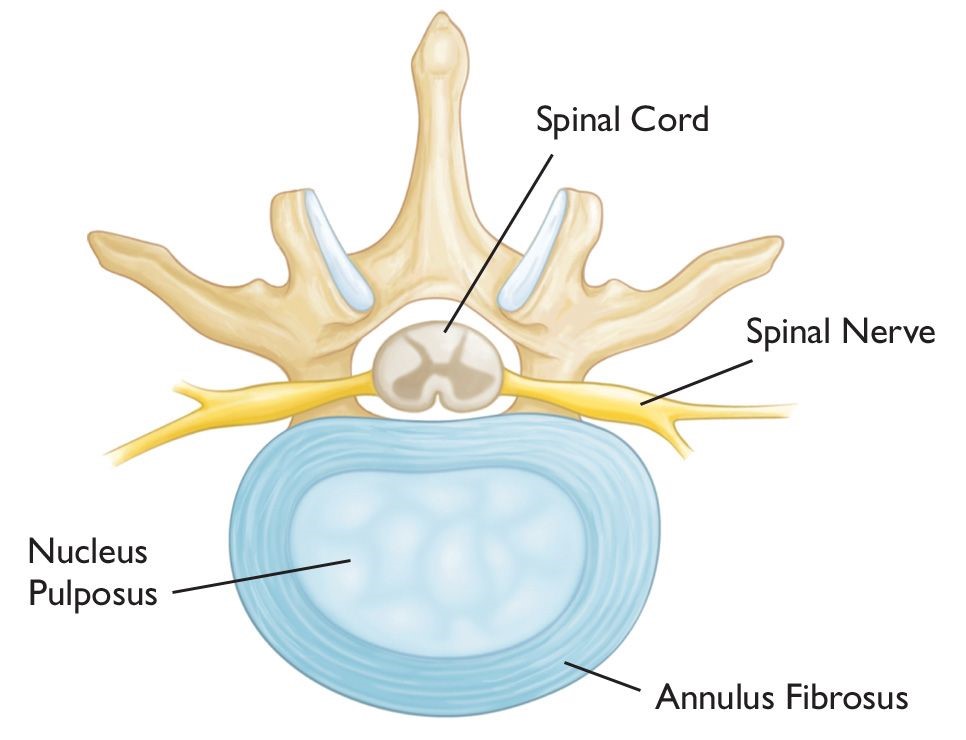
Healthy intervertebral disk (cross-section view)
Description
A disk begins to herniate when its jelly-like nucleus pushes against its outer ring due to wear and tear or a sudden injury. This pressure against the outer ring may cause lower back pain.
If the pressure continues, the jelly-like nucleus may push all the way through disk’s outer ring or cause the ring to bulge. This puts pressure on the spinal cord and nearby nerve roots. In addition, the disk material releases chemical irritants that contribute to nerve inflammation. When a nerve root is irritated, there may be pain, numbness, and weakness in one or both of your legs, a condition called “sciatica.”

In a herniated disk, the soft, jelly-like center of the disk can push all the way through the outer ring. (Side and cross-section views shown.)
Herniated Disk
A herniated disk is most often the result of natural, age-related wear and tear on the spine. This process is called disk degeneration. In children and young adults, disks have high water content. As people age, the water content in the disks decreases and the disks become less flexible. The disks begin to shrink and the spaces between the vertebrae get narrower. This normal aging process makes the disks more prone to herniation.
A traumatic event, such as a fall, can also cause a herniated disk.
Risk Factors
Certain factors may increase your risk of a herniated disk. These include:
Gender. Men between the ages of 20 and 50 are most likely to have a herniated disk.Improper lifting. Using your back muscles instead of your legs to lift heavy objects can cause a herniated disk. Twisting while you lift can also make your back vulnerable. Lifting with your legs, not your back, may protect your spine.Weight. Being overweight puts added stress on the disks in your lower back.
Repetitive activities that strain your spine. Many jobs are physically demanding. Some require constant lifting, pulling, bending, or twisting. Using safe lifting and movement techniques can help protect your back.
Frequent driving. Staying seated for long periods, plus the vibration from the car engine, can put pressure on your spine and disks.
Sedentary lifestyle. Regular exercise is important in preventing many medical conditions, including a herniated disk.
Smoking. It is believed that smoking lessens the oxygen supply to the disk and causes more rapid degeneration.

How Can I Relieve My Lower Back Pain?
You feel it each time you bend over or stand up. It’s that groan-inspiring ache that shoots through your lower back and never seems to fully go away. Sometimes called lumbago or spondylosis, lower back pain is one of the most common forms of chronic pain among adults.
Maybe you’ve been resting, hoping the back pain just needs time to heal. But most doctors now encourage lower back pain sufferers to get active and move their backs and related muscles as a better pain relief treatment.
Movement can help relieve back pain, but only the right kind; avoid workouts that put too much stress and strain on the back. So which exercises should you choose? That partly depends on how intense your pain is, and what causes it. So, you should always get the recommendation of your doctor before doing any heavy exertion for lower back pain.
The following slides present several simple exercises that can help relieve lower back pain, and also highlight a few activities to avoid. With your doctor’s approval, adding these movements to your workout routine can free you from your nagging, daily pain, leading to better overall health.

Skip the Toe Touches
Fitness is often a great treatment for back pain, but some movements offer you little health benefit. Toe touches from a standing position can aggravate sciatica and other conditions by overstressing ligaments and spinal disks. Another cause for concern is the way standing toe touches can overstretch hamstrings and muscles in your lower back.
How Much Pain Is Too Much?
Some mild discomfort and pain can be expected anytime you start a new workout. As you work your way back to better health and your muscles strengthen, that pain and discomfort should disappear. But when a fitness routine causes moderate or severe pain symptoms that lasts longer than 15 minutes, you should end the exercise and check in with your doctor.
Pain Relief: Try Partial Crunches
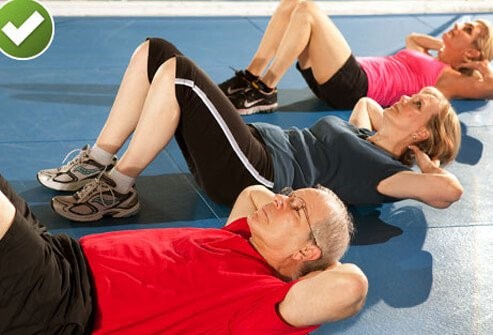
One of the classic core-strengthening workouts is the partial stomach crunch. Partial crunches build strength in both your lower back and related stomach muscles, making this an ideal exercise for people with spondylosis.
Here’s how to get the most out of partial crunches:
- Lie back, and keep your feet flat on the floor with your knees bent.
- With your hands behind your head or with arms crossed around your chest, raise your shoulders from the floor. Make sure to keep your stomach muscles tight.
- Breath out while raising your shoulders. Avoid leading with your elbows (or yanking your neck off the floor with your arms).
- Hold for one second. Next, lower yourself back down to the floor in a controlled manner.
- Repeat with between eight and 12 repetitions. Remember to follow proper form, which prevents excessive spine stress. Keep your feet, tailbone, and lower back against the floor throughout the exercise.
Skip the Sit-Ups
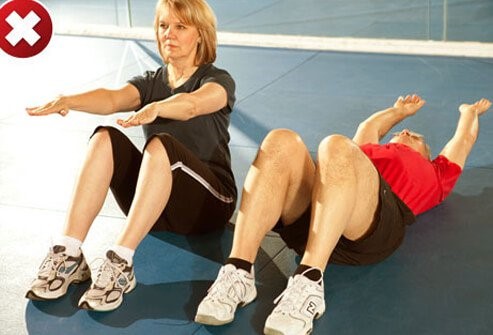
Sit-ups are a fitness standard, but they’re not as good at strengthening your core as you may think.
Although most people see sit-ups as a stomach-strengthening activity, in reality people often use their hip muscles more than their stomachs when doing this exercise.
Not only are they a poor choice for core strength, but sit-ups create pressure on spinal disks, which can lead to injury by increasing your lower back pain rather than lowering it. To maintain good health and improve low back pain, try more suitable workouts like the ones outlined further on.
Hamstring Stretches
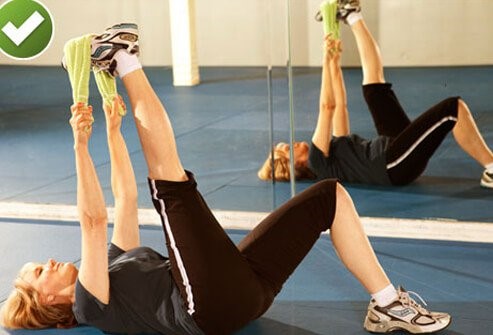
Hamstring stretches relieve the back of the leg, where some of the muscles that support the work of the lower spine are found. As shown in the photo, this is a stretch that benefits from the use of a towel or fitness band.
To perform a hamstring stretch, follow these steps:
- First, lie on your back with one knee bent.
- Next, thread a towel beneath the ball of the foot on the unbent leg.
- Pull back on the towel slowly, straightening your knee. You ought to feel a gentle stretch along the back of your leg.
- Hold the stretch for at least 15-30 seconds.
- For each leg, repeat 5 times.
Avoid Leg Lifts
Once in a while, leg lifts are suggested as useful treatments for lower back pain. That’s because they help strengthen abdominal muscles, which play an important part in back health. Unfortunately, lying on your back and lifting both legs together can worsen back pain, and could cause injury.
Instead of relying on leg lifts for better spine health, try this modified leg lift for lower back pain:
- First, lie on your back. Leave one leg straight, and bend the other leg at the knee.
- Next, lift the straight leg slowly up about six inches from the ground and briefly hold it in this position.
- Finally, slowly lower the leg.
- Repeat 10 times with the left leg, then switch to the right leg.
Wall Sits

When it comes to low back pain, try some wall sits as a break from sitting on the couch. To do these wall sits properly and without injury, follow these steps:
- Stand with your back facing the wall at a distance of about 10 to 12 inches.
- Carefully lean into the wall until your spine is flat against it.
- Slide down the wall slowly until your knees are bent slightly. Continue to press your low back into the wall.
- Hold this position for a count of 10, then carefully slide back up the wall. Repeat 8 to 12 times.
Press-up Back Extensions
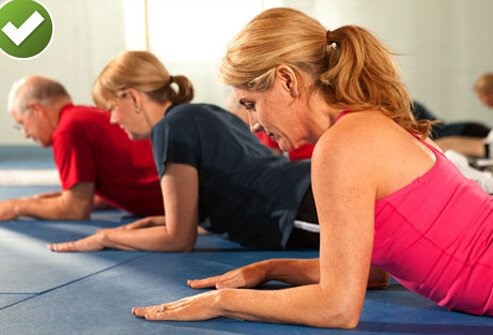
An other treatment for back pain symptoms is the press-up back extension. Here are the steps:
- Lie on your stomach. Position your hands directly underneath your shoulders.
- Push down on your hands. You should feel your shoulders begin to lift away from the floor.
- If you can do so comfortably, set your elbows on the floor directly beneath your shoulders. Then spend several seconds holding this position.
Bird Dog

It’s a bird! It’s a dog! No, it’s a fitness routine to ease low back pain! The bird dog is a great way to learn to stabilize the low back during movements of the arms and legs. Here’s how it is done:
- To begin, get on your hands and knees.
- Tighten your abdominal muscles.
- With one leg, lift and extend it behind you while keeping your hips level.
- Hold that position for a full five seconds.
- Now switch to the other leg.
- For each leg, repeat eight to 12 times. For an added challenge, try lengthening the time you hold each lift.
- For each repetition, try lifting and extending your opposite arm in front of you.
- Don’t allow your lower back muscles to sag.
- Stay in position—don’t lift your arms or legs any higher than the low back position can maintain.
Knee to Chest
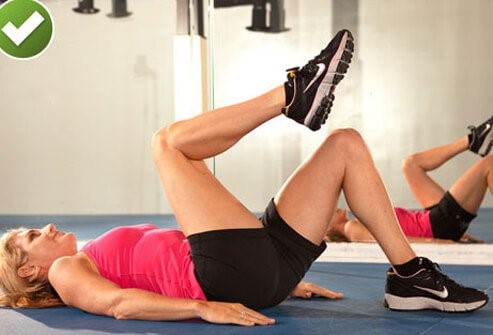
Here’s another way to get your legs pumping as a treatment for low back pain symptoms. Follow these directions to perform a safe knee-to-chest workout..
- Lie on your back. Put your feet flat on the floor and bend your knees.
- Draw your right knee up to your chest. Keep the left foot flat against the floor.
- Hold for 15-30 seconds. Meanwhile, be sure to keep your lower back flat on the floor.
- Next, lower your right knee. Repeat the routine with the left leg.
- For each leg, perform knee-to-chest two to four times.
Pelvic Tilts
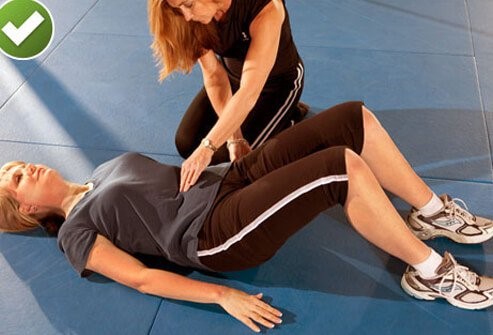
Before back pain has you writhing on the floor with the usual symptoms, try lying on your back for some pelvic tilts. This workout is designed to strengthen your pelvis, which often works in concert with the core muscles along your spine. Making sure your abdomen can pull its fair share means your spine pain will have one less possible cause.
- Lie with your back and upper body on the floor with your knees bent. Keep your feet flat on the floor.
- Pull in your stomach. Imagining your belly button is being pulled toward your backbone—this helps keep your stomach tight. Doing this, you will notice your hips rocking back as your back and spine press into the floor.
- Hold this movement for 10 seconds, allowing your breath to smoothly enter and exit your chest.
- Repeat your pelvic tilts eight to 12 times.
Glute Bridges (Bridging)
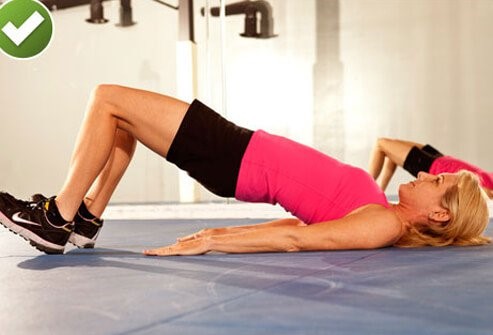
ing offers so much for the symptoms of back pain. This exercise helps strengthen various supporting players for your back like the hamstrings, glutes, transverse abdominis, abdomen and hips. It also works directly to strengthen the lower back. Follow these steps to assure a safe and rewarding bridge workout:
- Lie with your back to the floor, knees bent with only your heels touching the floor.
- Dig your heels into the floor. Squeeze down on your glutes. Lift your hips up until your shoulders, hips, and knees make a single, straight line.
- Hold this position for about six seconds.
- Slowly bring your hips back to the floor and give yourself about 10 seconds of rest.
- Repeat bridges eight to 12 times.
There are a couple of things to remember when bridging. First, try not to arch your lower back while your hips are moving upward. Next, avoid overarching. You can do that by keeping your abdomen tight both before and throughout the lift.
Carefully Choose a Weight Lifting Regimen
If properly done, weight lifting will not exacerbate your back pain. In fact, you may feel that pain start to melt away as weight lifting begins to strengthen your lower back and supporting body parts.
However, when your back pain comes on suddenly (what doctors call acute pain), the additional stress of weight training could put you in harm’s way, potentially leading to injury. To use weight lifting as a back-pain treatment, start by talking to your doctor. Your doctor can advise you on whether or not to lift weights. If they are recommended, your physician can advise you on which workouts to stay away from.
Aerobic Exercises
Aerobic workouts—sometimes called cardio—help strengthen the whole cardiovascular system, from the lungs and heart down to the blood vessels themselves. Aerobics can include biking, swimming, walking, or many other exercises that elevate your heart rate and get you moving. To start, try a short session. Then over time, lengthen the session as your stamina improves.
Since back pain sometimes requires special care, try swimming as a treatment for your symptoms. In swimming, the water supports your body weight, giving your back a break. Be careful to avoid any strokes that require your body to twist.
Some Pilates
A routine that incorporates strengthening and stretching with a focus on the abdominal core sounds ideal for those who suffer from back pain symptoms. Pilates is a training workout that sometimes uses an apparatus called a Reformer to emphasize flexibility and endurance along with strength. But many Pilates exercises can be performed without any special equipment.
With help from an experienced instructor, Pilates may help some people with low back pain. Make sure your instructor knows about your pain ahead of time, as you may need to skip some moves.
Why Smart Behan?
Smart Behan is the main platform to provide medical information to address your health issue. Our network introduces best hospital and centers in iran offering high quality services and expert Best Doctors and Surgeons in Iran as well as booking appointment. You can manage your medical travel. Smart Behan accompanies you from airport to airport handling Welcoming, transportation, translation, medical treatment and last not the least follow up when you are back to home.
Smart Behan can also make an appointment with our Orthopedic Surgeon Dr.Zakieh Meshksar for your consultation and surgery.
To view the rest of our training posts, you can click here

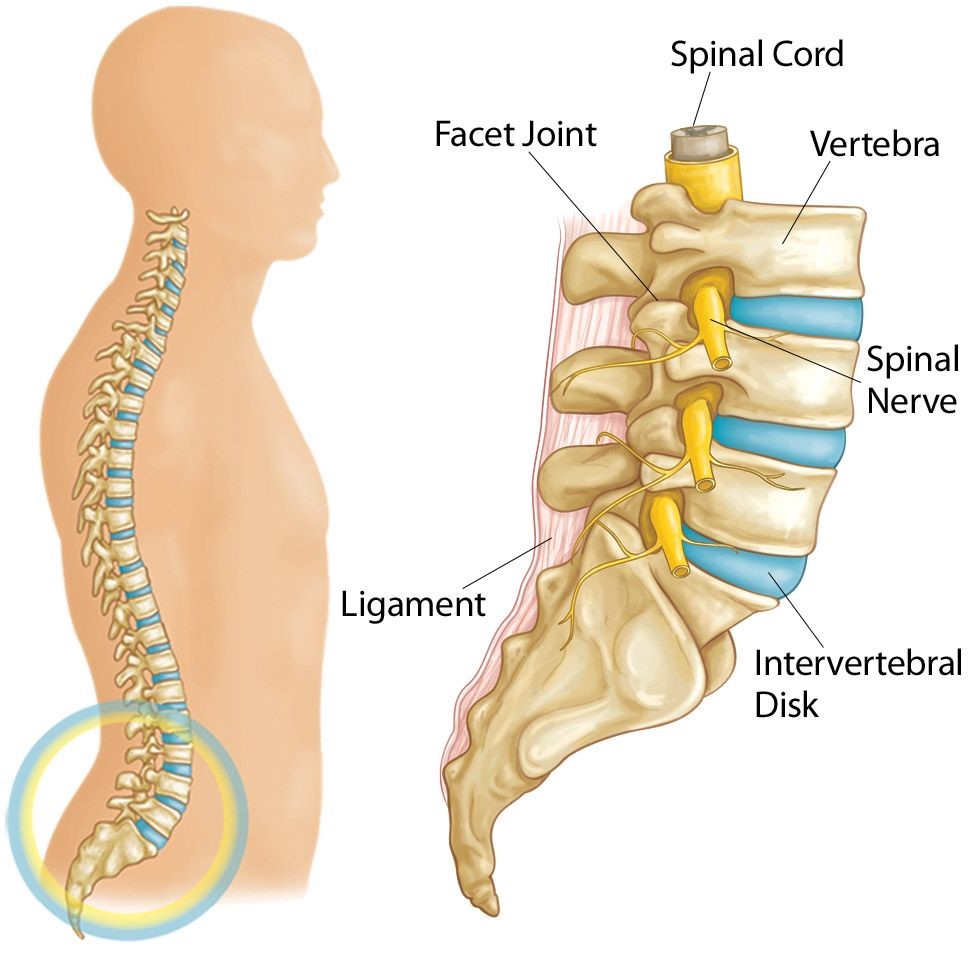

4 Comments
zoritoler imol
I’m really enjoying the theme/design of your blog. Do you ever run into any browser compatibility issues? A few of my blog visitors have complained about my website not working correctly in Explorer but looks great in Safari. Do you have any tips to help fix this issue?
arezo
Structure and function of the spine Solve problems In Iran.
It was an interesting article. Do not be bored
smartbehan
Thank you for your beautiful answer
maryam
It was a really comprehensive article. Thank you for your useful information. Good luck